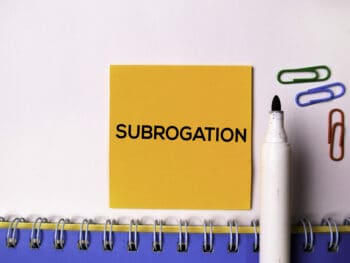The job of a workers’ compensation claim handler and manager goes beyond serving their clients and injured workers. It also includes watching out for a programs bottom line and seeking creative solutions to complex problems. This job includes a number of different tasks. One important role in this area is identifying potential subrogation issues. This results in reimbursement of monies paid out by a program from third parties playing a role in the work injury.
Subrogation Defined
Subrogation is defined by Black’s Law Dictionary as, “The principle under which an insurer that has paid the loss under an indemnity policy is entitled to take on all the rights and remedies belonging to the insured against a third party with respect to any injuries or breaches covered by the policy.”
Better Understanding Subrogation
To put this in plain English, subrogation is the opportunity to recover under a legal theory when the workers’ compensation insurer is required to make payment in the form of benefits to a party sustaining injuries due to the conduct or action of another. Imagine the following situation:
Employee sustains a work injury while operating a power tool. As a result of the work injury, the Insurer pays for various medical and indemnity benefits to and on behalf of the Employee. During the course of investigating the work injury, Insurer discovers the power tool used by the Employee had a design defect. While the Insurer is obligated to pay for various workers’ compensation benefits, the Insurer also has a right of subrogation against the manufacturer (and other parties) responsible for the defective product.
Work Comp Subrogation in the Real World
Opportunities to seek subrogation happen in more instances than one would think in the modern workplace. This requires that members of the claim management team investigate their cases and seek opportunities to recover monies in instances where another’s conduct played a role in the injury.
Motor vehicle accidents:
MVAs are the leading area of subrogation in workers’ compensation claims nationwide. Every day, thousands of people are involved in MVAs that take place in the course and scope of their employment. This is an area, which is subject to legal standards outside the area of most non-attorneys understanding. It is important to consult with attorneys as to the likelihood one can obtain recovery. When investigating these types of cases, it is important for claims handlers to:
- Obtain police reports regarding the MVA;
- Secure photographs, witness information and statements as to how the accident occurred; and
- Determine what insurance companies are involved.
Premises Liability:
The traveling employee or people who work at another’s property are subject to numerous hazards. This includes parking lots or facilities that are not properly maintained, wet or icy surfaces and other perils. It is important to act quickly when these types of injuries occur as key evidence can get changed/altered and even destroyed—sometimes accidently. Key investigation tips include:
- Photographs of the accident scene;
- Investigate and obtain information as to witnesses to the incidents and their connection with the premises involved; and
- If these incidents take place at construction site, it is important to obtain information on the use of safety equipment and any OSHA investigation information.
Products Liability:
These incidents occur when employees are working with machinery, heavy equipment and power tools. It is also important to act fast to preserve the potentially problematic item that contributes to the injury. It is also important as part of your investigation to determine the following:
- The make, model and year of purchase of the equipment causing the injury; and
- Whether there were any alterations to the equipment or machine causing the injury, and who made/ordered the changes to be made.
Conclusions
Effective subrogation is an important aspect of every workers’ compensation program. While the insurance carrier is still required to compensate the injured worker, the recovery of those funds leads to a successful and cost-efficient program.
Author Michael Stack, Principal, COMPClub, Amaxx LLC. He is an expert in workers compensation cost containment systems and helps employers reduce their work comp costs by 20% to 50%. He works as a consultant to large and mid-market clients, is co-author of Your Ultimate Guide To Mastering Workers Comp Costs, a comprehensive step-by-step manual of cost containment strategies based on hands-on field experience, and is founder of COMPClub, an exclusive member training program on workers compensation cost containment best practices. Through these platforms he is in the trenches on a working together with clients to implement and define best practices, which allows him to continuously be at the forefront of innovation and thought leadership in workers’ compensation cost containment. Contact: mstack@reduceyourworkerscomp.com.
©2016 Amaxx LLC. All rights reserved under International Copyright Law.
Do not use this information without independent verification. All state laws vary. You should consult with your insurance broker, attorney, or qualified professional.






